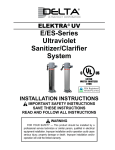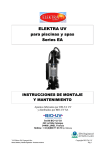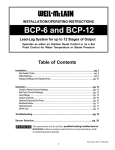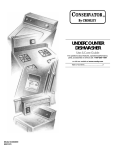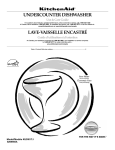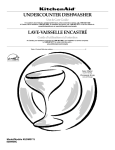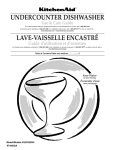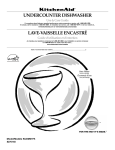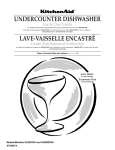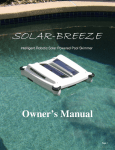Download Electra DELTA 21ST Unit installation
Transcript
ELEKTRA PRO UV ® EP Series Ultraviolet Sanitizer/Clarifier System INSTALLATION INSTRUCTIONS IMPORTANT SAFETY INSTRUCTIONS SAVE THESE INSTRUCTIONS READ AND FOLLOW ALL INSTRUCTIONS WARNING FOR YOUR SAFETY — This product should be installed by a professional service technician or similar person, qualified in electrical equipment installation. Improper installation and/or operation could cause serious injury, property damage or death. Improper installation and/or operation will void the limited warranty. INSTRUCTIONS PERTAINING TO RISK OF FIRE, ELECTRIC SHOCK OR INJURY TO PERSON WARNING — When using this unit, basic precautions should always be taken, including the following: 1. READ AND FOLLOW ALL INSTRUCTIONS. 2. DANGER: To reduce the risk of injury, do not permit children to use this unit unless they are closely supervised at all times. 3. Use this unit only for its intended use as described in this manual. Do not use attachments not recommended by the manufacturer. 4. Never drop or insert any object into any opening. 5. This unit contains an ultraviolet bulb that can cause discomfort or irritation to the eyes if viewing while operating. Prolonged exposure to the eyes can cause blindness. DO NOT VIEW UV BULB WHILE OPERATING OR DURING MAINTENANCE. 6. The unit must be connected only to a supply circuit that is protected by a Ground Fault Circuit Interrupter (GFCI). If this unit is not equipped (optional) with a GFCI, a GFCI should be provided by the installer and should be tested on a routine basis. To test the GFCI, push the test button. The GFCI should interrupt power. Push the reset button. Power should be restored. If the GFCI fails to operate in this manner, the GFCI is defective. If the GFCI interrupts power to the unit without the test button being pushed, a ground current is flowing, indicating the possibility of an electric shock. Do not use this unit. Disconnect the unit and have the problem corrected by a qualified service representative before using. 7. ENVIRONMENTAL NOTICE – Hg-Lamp CONTAINS MERCURY. Manage in accord with disposal laws. See: www.lamprecycle.org SAVE THESE INSTRUCTIONS 2 SAVE THESE INSTRUCTIONS INSTALLATION INSTRUCTIONS WARNING When using electrical products, basic precautions should always be followed, including the following: 1. DANGER: RISK OF ELECTRIC SHOCK. Connect only to a circuit protected by a Ground Fault Circuit Interrupter. 2. Grounding is required. The unit should be installed and grounded by a qualified service representative. 3. Install to permit access for servicing. IMPORTANT: Follow the instructions below EXACTLY and IN THE ORDER LISTED. Once installed, your UV unit will provide years of successful operation. TABLE OF CONTENTS 0.0 1.0 2.0 3.0 4.0 5.0 6.0 7.0 Forward Introduction Pre-Installation 2.1 Pond Turnover Rates 2.2 Swimming Pool Turnover Rates Desired Flow Rate Chart – Ponds Desired Flow Rate Chart – Swimming Pools, Fountains, Water Features Installation 5.1 Locating The UV Unit 5.2 Plumbing The UV Unit – Plumbing Diagram and Bypass Diagram 5.3 Installing Inlet/Outlet Unions 5.4 Installing Pressure Gauge 5.5 Mounting The UV Unit On A Solid Base 5.6 Gluing Piping To The UV Unit 5.7 Electrical Connection 5.8 Electrical Bonding (Grounding) 5.9 Safety Pressure Switch Start-up 6.1 Pump Start-up 6.2 Leak Check Total System 6.3 Swimming Pool Chemical Balance Maintenance – Quartz Tube Removal 7.1 Disconnect Power 7.2 Stop Circulation Pump 7.3 Remove Electrical Bonnet 7.4 Remove UV Bulb 7.5 Remove Bulb Holder Acorn Nut 7.6 Remove Quartz Tube 7.7 Cleaning Quartz Tube 3 8.0 9.0 10.0 11.0 12.0 13.0 14.0 15.0 16.0 17.0 18.0 19.0 Quartz Tube Installation 8.1 Inserting Quartz Tube 8.2 Seating Quartz Tube 8.3 Sealing Gasket Installation 8.4 Acorn Nut Installation 8.5 Leak Checking Quartz Tube UV Bulb Installation 9.1 Seat Bulb End Cushion 9.2 Install O’Rings On Bulb End 9.3 Insert Bulb Into Quartz Tube 9.4 Ballast and Bulb Caution 9.5 Install Ballast Socket On Bulb 9.6 Install Electrical Enclosure Bonnet 9.7 Plug UV Unit Into Electrical Power 9.8 Turn Pump Back On Maintenance – Scheduled Bulb Replacement 10.1 Schedule Of Replacement 10.2 Disconnect Power Source 10.3 Electrical Enclosure Bonnet Removal 10.4 Steps To Follow For Bulb Replacement Additional UV Unit Maintenance Normal Operating Results 12.1 Ponds 12.2 Swimming Pools, Fountains, Water Features, Waterfalls Winterizing 13.1 Freeze Damage 13.2 Water Removal From Inside Of UV Unit Swimming Pool Chemicals How To Obtain Service Parts Schematic and Part Numbers Frequently Asked Questions 17.1 Salt Water Use 17.2 Filter Cleaning 17.3 Time Clock Operation 17.4 Residual Effect From UV 17.5 Horizontal Mounting Of UV Unit 17.6 Below Water Installation 17.7 Multiple UV Units For Larger Installations 17.8 GFCI (Ground Fault Circuit Interrupter) Necessity Troubleshooting 18.1 UV Bulb Will Not Light At Startup 18.2 UV Bulb Was Lit, But Is Not Lit Now 18.3 UV Bulb Stays Lit When Pump Is Off 18.4 Water Is Green 18.5 GFCI Trips 18.6 Unit Makes Noise When Operating 18.7 Water Leaks From Electrical Enclosure Bonnet Specification Changes 4 0.0 Forward: The Elektra® Pro UV Unit is designed for use in swimming pools, fountains, water features, waterfalls and fish ponds. It is not designed for use in potable (drinking) water installations. Use of this product in applications other than those indicated above will void your warranty and could be harmful to your health or the health of others. 1.0 Introduction - How The Elektra® Pro UV Unit Works: Within the Electra® Pro UV Unit (which we will refer to throughout this manual as EP), a high intensity electrically operated Ultraviolet (UV) bulb is located inside the unit’s wet chamber. This UV bulb gives off Ultraviolet light wave emissions when lit. The bulb’s operating emission range is within the Ultraviolet light wave spectrum at 253.7 nm of wavelength. This wavelength is such that when bacteria, protozoa, viruses, algae spores, or other single celled waterborne microorganisms in the incoming water flow are exposed to the light waves of the UV bulb for one second or more exposure time, the DNA of the microorganism is altered or disrupted, which controls and eradicates these unwanted contaminates and renders them harmless. Pond or pool water containing these unwanted contaminates enters the EP unit’s wet chamber and is exposed to the light rays generated by the UV bulb. The EP unit has been designed to allow for some turbidity in the water, as turbidity will reduce the UV light wave transmission capability. Therefore, all EP units are sized with sufficient exposure time to allow for possible turbidity in the water and the reduction in the killing power of the UV bulb when it nears the end of its useful life. When the incoming water is exposed for this duration, the water exiting the unit is near drinking water biological quality. CAUTION!: THIS UNIT IS FOR POND OR POOL USE ONLY. DO NOT USE THIS UNIT FOR POTABLE (DRINKING) WATER SANITIZATION. 2.0 Pre-Installation - In order to ensure that your EP unit functions with the proper exposure time to achieve the desired water sanitization, it is important to provide the proper water flow rate through the EP unit. If water passes through the unit too quickly, the exposure time of the microorganisms to the UV bulb produced rays will not be sufficient to obtain the desired kill rate. The water flow rate through the UV unit is governed by the piping of your pool or pond and the size and output of your circulation pump. There also needs to be consideration to the application for the UV unit. Fish ponds have different requirements than do swimming pools, water features, fountains, or waterfalls. 2.1 Pond Turnover Rates - Most fish pond experts agree that there is no set formula for the sizing of circulation pumps and UV systems for ponds. The size of the pond, the depth, plant coverage, the amount of sun exposure or shade, and the number of fish in the pond all contribute to determining what the flow rate for a pond should be. The best advise is to consult with a pond expert to determine what the flow rate for your pond should be. This is the best method of ensuring that your pond is being circulated properly. But absent of that, a general rule of thumb that can be used for ponds is that the water volume of the pond should be passed through the filter system every two hours or so. Thus, if you take the volume of your pond (in gallons), and divide that by 120 (the number of minutes in two hours) you will have an approximate desired flow rate for your pond. Then, you select a pump and filter system that works properly at that flow rate. As an example, a 6000 gallon pond would have a desired flow rate of 50 gallons per minute (GPM) calculated at 6000 /120 = 50. 2.2 Swimming Pool Turnover Rates - Swimming pools are somewhat simpler to calculate for flow rates. Most residential pools are designed to have the capacity of the pool turned over every 12 hours. Semicommercial pools are normally designed for an 8 hour turnover flow rate. Check with your local jurisdiction for the required flow rate for your type of pool to be sure. Thus, as an example, using the same formula as above, a 20,000 gallon residential pool will need to have a pump capable of a 28 GPM flow rate and a 25,000 gallon Semi-commercial pool will need to have a pump capable of 52 GPM. Like pools and ponds, the EP unit needs to be properly sized by flow rate. Moving the water through the EP unit’s wet chamber too fast will not allow enough exposure time of the water to be exposed to the UV bulb rays for the two second minimum required. The chart below shows the desired and maximum flow rates for your EP unit. Make sure the flow rate of your circulation system pump does not exceed the maximum allowable flow rate of the UV unit you have selected. (Consult your dealer or pump manufacturer for the pump’s GPM rating if you are in doubt). If the pump output exceeds the maximum flow rate of the EP unit you have selected, select an EP model with a higher flow rate capacity rating or consider a multiple unit installation. (See Sec.17.7). 5 3.0 Desired UV Unit Flow Rates – Ponds Delta UV Maximum Maximum Minimum UV EP UV Flow Rate Flow Rate Microwatts Model (GPM) (LPM) sec/cm² (Gallons) (Liters) (Gallons) (Liters) (Gallons) (Liters) 31 63 88 100 117 238 333 379 30290 30840 30290 30980 3720 7560 10560 12000 14082 28618 39974 45425 5580 30240 42240 48000 21123 114470 159895 181699 7440 15120 21120 24000 28163 57235 79948 90850 EP-5 EP-10 EP-20 EP-40 Max Volume Max Volume Max Volume Max Volume Max Volume Max Volume 2 Hr. Turnover 2 Hr. Turnover 3 Hr. Turnover 3 Hr. Turnover 4 Hr. Turnover 4 Hr. Turnover Note: Multiple EP units can be used for flow rates beyond those specified herein. (See Sec. 17.7) - Do not exceed 8ft/sec flow rate for your piping. 4.0 Desired UV Unit Flow Rates – Swimming Pools, Fountains, Water Features Delta UV Maximum Maximum Minimum UV Max Volume Max Volume Max Volume Max Volume EP UV Flow Rate Flow Rate 12 Hr. Turnover 12 Hr. Turnover 8 Hr. Turnover 8 Hr. Turnover Model (GPM) (LPM) Microwatts sec/cm² (Gallons) (Liters) (Gallons) (Liters) 31 63 88 100 117 238 333 379 30290 30840 30290 30980 22320 45360 63360 72000 84490 171706 239843 272549 14880 30240 42240 48000 56327 114470 159895 181699 EP-5 EP-10 EP-20 EP-40 Note: Multiple EP units can be used for flow rates beyond those specified herein. (See Sec.17.7) - Do not exceed 8ft/sec flow rate for your piping. Sizing Chart Notes: The GPM/LPM flow rates shown are to illustrate the maximum bacteria killing capacity of the UV unit. In practical application, the flow rates through your plumbing system should not exceed 8ft/sec. - By maintaining your flow rate at or below the maximum flow rates shown, you will achieve the same killing power output in micorwatts/ sec/cm2 as used by Public Health officials worldwide for potable drinking water. Upsizing your unit to the next larger size further improves the sanitation achieved without much appreciable increase in purchase cost, when used with a lower output pump. 5.0 Installation - Before starting your installation, PLEASE read this manual cover to cover. A few moments spent initially becoming totally familiar with the EP unit and its installation will save wasted time (and expense) later on. If you have any questions that are unanswered when you have completed the reading of this manual, contact your supplier or Delta UV to get the answers you need before going forward and creating a problem later on by proceeding incorrectly. We want to have your installation meet your expectations and operate properly and are ready to assist you at any time. 5.1 Locating The UV Unit - Once you have confirmed the sizing of your pond or pool and compared that information against the requirements of your EP UV unit by using the charts above, it is now time to install your unit. The EP unit comes with all internal components fully assembled and ready for installation. Only the Inlet/Outlet unions and pressure gauge need to be installed to ready your unit for installation. The housing of the EP UV unit is stainless steel and the electrical enclosure bonnet is UV inhibited ABS plastic. Thus, your unit will function fine in the outdoors. Installing the EP unit indoors or inside a covered area is preferred, however, to keep your unit looking new. The EP unit will need to be powered from a 120 V/15A electrical outlet. If the outlet is outdoors and open to the weather, it will need to be an Outdoor type receptacle. The EP unit comes with an eight foot power cord. Do not use an extension cord unless it is at least a 16/3 size conductor waterproof type and is no longer than twenty five (25) feet long. Note: 240V / 50/60HZ units are available - Contact your dealer for more information. 5.2 Plumbing The UV Unit – Plumbing Diagram and Bypass Diagram - Your EP unit will next need to be plumbed into your pond or swimming pool circulation system. The diagram (Fig. 1) shows how the unit is to be plumbed. Note that the water is to be piped from the pressure side of the pump and after the filter, in and out of the EP unit. The inlet for the water is at the bottom of the EP unit, and the outlet is at the top of the EP unit. If your pump exceeds the maximum flow rate of the EP unit, installation of a plumbing by-pass will be 6 5.3 Installing Inlet/Outlet Unions - The EP unit comes with union nuts installed on the housing. Packed with your EP unit are the remaining components necessary to complete the Inlet/Outlet unions. The clear union tail piece is used on the top union, and the solid color union tail piece is used on the bottom union. Also packed with your EP unit are two white gaskets that are used to complete the Inlet/Outlet unions. One side of the gasket is flat, the other side has a half round bead on the face. The two unions each have a groove in the face of the union tail piece and that groove accepts the half round bead of the gasket to hold the gasket in place correctly. Place the gaskets into the face of the union tail pieces. Now, install the union tail pieces by screwing them into the union nuts on the EP unit. DO NOT OVERTIGHTEN. Hand tightening is sufficient. OVERTIGHTENING WILL BREAK THE UNION NUTS. 5.4 Installing Pressure Gauge - Your EP unit also comes with a pressure gauge that is used to confirm that your pump is not exceeding the 40 PSI maximum working pressure for the EP UV unit. The pressure gauge is shipped with Teflon sealing tape on the gauge threads. To install the pressure gauge, you screw it into the threaded tap on the clear union tail piece that you have installed on the EP unit. If the EP unit is installed indoors, the pressure gauge can be installed so it is facing upward. However, if the EP unit is installed outdoors, the pressure gauge must be installed on one side or the other of the clear tailpiece so that it will be in a vertical position when installed. Installing the gauge facing upwardly when the EP unit is outdoors will result in the gauge filling full of rainwater and will ruin the gauge. The gauge location and orientation that you choose is dependent upon which side of the fitting provides the best viewing of the gauge dial. Be sure to use a wrench to tighten the pressure gauge into the clear tail piece, using the square brass boss on the back of the pressure gauge. DO NOT OVERTIGHTEN. Over tightening will cause the clear plastic union tail piece to crack. Three or four threads are all that is necessary to seal the pressure gauge. If the gauge leaks upon start-up, simply tighten one more rotation. DO NOT TIGHTEN BY GRASPING THE COVER OF THE PRESSURE GAUGE. Only use the square brass boss on the back of the pressure gauge for tightening with a wrench. 5.5 Mounting The UV Unit On A Solid Base - The next step is to secure the EP unit to a concrete or wood base. Four mounting holes are located in the mounting base of the EP unit. These holes accommodate ¼ inch diameter bolts to mount the EP unit in place . FAILURE TO PROPERLY SECURE THE UNIT MAY CAUSE NOISE DUE TO VIBRATION CAUSED BY WATER PASSING THROUGH THE WET CHAMBER. Secure the EP unit using bolts and anchors where necessary and appropriate for your installation. (not supplied) When the EP unit is secured in position, the piping of the unit can begin. 7 5.6 Gluing Piping To The UV Unit - The Inlet/Outlet PVC union tail pieces are 2 inch pipe size (63mm for overseas models). Your PVC supply piping should be glued into the union tail pieces using an appropriate PVC primer and PVC cement, as recommended by your supplier. Inlet piping should be supported and should not rest solely upon the unions, to avoid breaking the unions. The installation of valves on the inlet and outlet lines attached to the UV unit is recommended. If the EP unit is located with any portion of the unit below the surface of the pond or pool, then VALVES ARE MANDATORY ,so you may winterize or remove the EP unit without draining your pool or pond. When you have completed the piping installation (including bypass if necessary), the final step is to plug in the unit to its power source. 5.7 Electrical Connection - The electrical power rating for your EP unit is shown on the label on the outside of the unit. US and Canadian EP units operate on 120 V/50/60 Hz – (1.15 Amps maximum). This low power consumption makes operating your EP unit very economical. Therefore, you will need a 15Amp 120V receptacle for your EP unit to plug into. (Check the label on your overseas unit for its power requirement). Your EP unit is supplied with an eight foot long weatherproof power cord terminating in either a 3-prong grounded NEMA plug, or in an optional cord connected Ground Fault Circuit Interrupter (GFCI). Whether you use the factory installed GFCI or install a GFCI in the electrical outlet or in the breaker panel serving the EP unit power receptacle, you will need to have the unit GFCI protected. Note: Should the electrical power cord of your EP unit become frayed or damaged in the future, unplug it from the power receptacle and replace it immediately. If you did not order your EP unit with the cord connected GFCI installed, you may add it in the field. You will need to order Part # 70-09012 (Retrofit Cord Connected GFCI Kit) from the supplier of your EP unit. This kit comes complete with everything you need to install the weatherproof GFCI on the end of the EP unit power cord. Easy to follow installation instructions are included with the kit and should take only a few minutes to complete. Verify that you have power to your electrical outlet and then plug the EP unit power cord into your power outlet. 5.8 Electrical Bonding (Grounding) - As required by Article 680, NEC and many local electrical codes, all metallic equipment of your pond or swimming pool system must be electrically bonded to a common bonding grid, using a continuous #8 bare copper wire to connect all components (pump, filter, EP unit) together using the ground lugs supplied with each component. The EP unit has a copper grounding lug located on one leg of the mounting base for this function. Connect the bonding wire from the bonding grid to the grounding lug supplied on the EP unit. The electrical installation is now complete. DANGER - RISK OF ELECTRICAL SHOCK - RISK OF INJURY OR DEATH IF ELECTRICAL INSTALLATION AND BONDING ARE NOT DONE PROPERLY. If you are in doubt, have this important work done by a Licensed Electrician! 5.9 Safety Pressure Switch - The EP UV unit is equipped with a safety pressure switch that does not allow the UV bulb inside the unit to light unless there is at least 5 PSI operating pressure inside the chamber. This is to ensure that the bulb will not create heat when the EP unit is empty or water is not flowing in the wet chamber. Such excessive heat can shorten the life of the UV bulb. Therefore, only when the pump is pumping water through the EP unit wet chamber will you be able to see the UV bulb glow and confirm that it is on. Note: Low pressure 1/2 psi pressure switches are available if you have a low pressure piping system (Found most frequently in Koi pump installations). Order P/N 70-02315. Without the circulation pump operating, you will not see the bulb light up just by plugging the unit into its electrical outlet. Once the pump is pumping water thought the EP unit, as confirmed by the indication of pressure on the pressure gauge, the bulb will light. To confirm that the bulb is indeed lit, you can view the glow of the bulb through the clear plastic union tail piece at the top outlet of the EP unit. This is the only location where you should attempt to view the UV bulb while it is on. The PVC union tail piece screens out the harmful UV rays and can be viewed with the naked eye without any damage to the eyes. If the bulb is not lit, check the troubleshooting section at the end of this manual. 8 6.0 Start-Up - Once you have completed all steps above, including (IMPORTANT) verification that the unit has no leaks anywhere, including a possible broken quartz tube damaged during transit, you are ready to start your unit up. 6.1 Start Up Circulation Pump - Once the pump is on, be sure to drain all air from your system through the air relief valve on the filter if so equipped. 6.2 Check EP Unit For Leaks - Make one final check for leaks in your piping, accessories, and under the electrical enclosure bonnet. If any water leakage under the EP unit’s electrical enclosure bonnet is suspected (water dripping from under side of bonnet), disconnect the EP unit immediately, remove the bonnet (see 7.3) and verify that there is either a) no leakage or b) stop the leakage of the quartz tube gasket. If quartz tube leakage is encountered, follow the instructions in Sections 7.4 through 7.6 and 8.1 through 8.5 to remedy the situation before applying electrical power to your EP unit. 6.3 Swimming Pool Chemical Balance - Check the chemical balance of your swimming pool and adjust the chemical balance as per your pool chemical suppliers instructions. Remember, the EP unit reduces chemicals, but does not eliminate the need for proper pool chemical balance. 7.0 Quartz Tube Maintenance - The EP unit requires very little maintenance during the year. The UV bulb in the EP unit is placed inside a quartz tube to protect the bulb from the water in the EP unit’s wet chamber. This quartz tube can have its ability to transmit the UV rays from the bulb through the quartz tube diminished if the quartz tube becomes dirty or laden with deposits. The quartz tube should be removed from the wet chamber every six (6) months and inspected to make sure it is clean and that deposits are not attached to the quartz tube. To remove the quartz tube, you should follow the steps shown below. 7.1 Disconnect Power - Unplug the EP unit from its power receptacle. 7.2 Stop Your Circulation Pump - You must shut off the circulation pump so that no water is flowing into the EP unit. Once the pump is shut off, verify on the pressure gauge that the pressure inside the EP unit is ZERO. If any pressure is indicated on the pressure gauge, do not go to the next step until the pressure gauge shows ZERO. If you show any pressure on the pressure gauge, but feel that there is no pressure present inside the EP unit, simply unscrew the top union nut on the EP unit. This will relieve any pressure. With the union partially unscrewed, the pressure gauge should show ZERO. If it does not, replace the pressure gauge (Part # 84-82234) immediately. When you are absolutely sure that there remains no pressure inside the EP wet chamber, you can proceed to the next step. 7.3 Remove The Plastic Electrical Enclosure Bonnet - NEVER REMOVE THE ELECTRICAL ENCLOSURE BONNET WITHOUT FIRST UNPLUGGING THE EP UNIT FROM ITS POWER SOURCE – DO NOT OPERATE THE EP UNIT WITH THE BONNET REMOVED - The electrical enclosure bonnet is removed by unscrewing the four mounting screws that hold the bonnet to the EP unit. 7.4 Remove The UV Bulb - First make sure the bulb is cool before handling. Do not handle a hot UV bulb to avoid burning your skin while handling the bulb to be removed. Unplug the UV bulb by grasping the white bulb connector attached to the ballast wires. Slowly pull the UV bulb out of the quartz tube by grasping the bulb on the white ceramic prong end. DO NOT TOUCH THE UV BULB GLASS WITH YOUR BARE HANDS ! Use a soft clean cotton cloth or clean cotton gloves to handle the UV bulb. Skin oils on your hands can attach to the bulb and can cause hot spots on the bulb which can shorten the bulb life. Carefully place the removed bulb in a safe location while cleaning the quartz tube. The quartz tube is now ready to be removed from the EP unit for cleaning. 7.5 Remove The Acorn Nut - Using a crescent wrench or 1-11/16” socket, remove the black plastic acorn nut (Part # 86-02411) holding the quartz tube into the stainless steel mounting gland. Note that there is a rubber sealing gasket (Part # 44-02018) around the quartz tube (or inside the acorn nut) that seals the quartz tube to the mounting gland. Set the gasket aside to reseal the quartz tube when you re-install the quartz tube after cleaning. 9 7.6 Remove The Quartz Tube - First make sure the quartz tube is cool. Do not handle a quartz tube until it cools. Grasp the quartz tube that is extended above the mounting gland and pull straight up to remove it from the EP unit wet chamber. The quartz tube can now be easily cleaned. 7.7 Cleaning The Quartz Tube - The quartz tube exterior can normally be cleaned by mixing a mild solution of Muriatic Acid (available at all pool supply stores)with water in a ratio of four parts water to one part acid. CAUTION: Follow the directions for use and handling of Muriatic Acid on the acid bottle label, being careful to protect your eyes, wear rubber gloves, and avoid breathing fumes. DO NOT USE ABRASIVE CLEANERS, as they can scratch the high quality quartz glass. If lime or hard water calcium deposits are encountered, lime removal products that are available in grocery stores can be used. These products will not harm the hard glass surface of the quartz tube. Complete the cleaning of the quartz tube, wash it off and wipe it dry. Make sure the inside of the tube is dry also before placing the UV bulb inside the quartz tube. Lastly, carefully inspect the cleaned quartz tube for cracks. If any cracks in the quartz tube are found, the tube should be replaced. Broken quartz tubes will allow water to enter the dry electrical chamber and attack the electrical components of the unit, which will cause them to fail and need to be replaced. BROKEN QUARTZ TUBES, OR WATER DAMAGE CAUSED BY BROKEN QUARTZ TUBES, ARE NOT COVERED UNDER YOUR LIMITED WARRANTY. 8.0 Reinstalling The Quartz Tube - The process of reinstalling the quartz tube is just the reverse of the removal process. 8.1 Inserting Quartz Tube - Insert the quartz tube into the wet chamber by carefully inserting it into the threaded stainless steel quartz tube sealing gland. 8.2 Seating Quartz Tube - Seat the quartz tube into the receptor at the bottom of the wet chamber. The quartz tube will not go all the way down into the wet chamber unless the rounded end of the quartz tube is seated in the receptor at the bottom of the wet chamber. 8.3 Sealing Gasket Installation - Place the black rubber sealing gasket all the way down into the black plastic acorn nut, with the angled edge of the gasket facing downwardly when the nut is installed on the sealing gland. DO NOT place the gasket on the quartz tube and then try to push the acorn nut over the gasket. This will not allow the gasket to seal properly. 8.4 Acorn Nut Installation - Screw the acorn nut onto the threads of the sealing gland, being careful not to cross thread the plastic nut. Tighten the acorn nut with a wrench, socket or crescent wrench. DO NOT OVERTIGHTEN. This will crack the acorn nut and the rubber gasket will not seal the quartz tube properly. 8.5 Leak Checking Quartz Tube - Turn the circulation pump on and check the quartz tube seal for leaks. Correct any leak found by carefully tightening the acorn nut ¼ turn. If the leak persists, remove the acorn nut and bulb sealing gasket, inspect the bulb sealing gasket and replace if necessary. Follow previous procedures for installing the acorn nut and seal and re-check the EP unit for leaks again. Turn the circulation pump off once you have confirmed that the quartz tube is not leaking 9.0 Reinstalling The UV Bulb - DO NOT TOUCH THE UV BULB GLASS WITH YOUR BARE HANDS. Oils on your hands transfer to the bulb glass and cause hot spots on the bulb surface. If you have touched the bulb with your bare hands, you must wipe the bulb glass off with Denatured Alcohol using a clean soft cotton cloth before inserting the bulb back into the quartz tube. 9.1 Seat Bulb End Cushion - Seat the bulb end cushion on the end of the bulb (the end that goes down into the quartz tube first). 9.2 Install O’Rings On Bulb End - Place the two O’Rings around the top white porcelain bulb end cap (where the electrical pins are located). 10 9.3 Insert Bulb Into Quartz Tube - Slowly lower the bulb down into the quartz tube, until the bulb O’Rings are down inside the quartz tube. Make sure the bulb O’Rings have not become dislodged from the white ceramic on the end of the bulb while the bulb is being inserted down into the quartz tube. Re-position the bulb O’Rings if necessary. 9.4 Ballast and Bulb Caution - CAUTION: DO NOT INSTALL THE ELECTRICAL SOCKET FROM THE BALLAST TO THE FOUR PINS ON THE END OF THE BULB AT THIS TIME. DOING SO NOW WILL CAUSE THE BULB TO LIGHT WHEN THE PUMP IS TURNED ON AND EXTENDED VIEWING OF THE LIGHT BULB CAN CAUSE BLINDNESS OR EYE INJURY. DO NOT LOOK DIRECTLY AT THE LIT BULB AT ANY TIME. 9.5 Install Ballast Socket On Bulb - Once you have verified that the quartz tube seal is not leaking, TURN OFF YOUR PUMP IF YOU HAVE NOT DONE SO PREVIOUSLY. Then, WITH THE PUMP OFF, connect the electrical socket from the ballast to the four pins on the bulb by pushing the socket down over the pins. NOTE: The socket will only install on the bulb pins in two opposite orientations. The pins are not equally spaced in all directions, so check the pin alignment before pushing down on the electrical socket. Once you are sure that the socket openings mate up to the pins, you can push the socket down onto the pins. DO NOT force the socket onto the pins. If force is needed, it means you have not aligned the pins to the socket. 9.6 Install Electrical Enclosure Bonnet - Reinstall The Electrical Enclosure Bonnet – Place the plastic electrical bonnet on the top of the EP unit on the four stand-offs provided, and tighten the screws using a Phillips screwdriver. Make sure the star washers on the screws are located on the outside of the electrical enclosure bonnet. They keep the electrical enclosure bonnet securely in place. DO NOT over tighten the screws. 9.7 Plug UV Unit Into Electrical Power - Plug The EP Unit Power Cord Into The Power Receptacle – The bulb will not light until the pump is turned back on, due to the pressure switch remaining open until pump pressure inside the wet chamber is sensed, verifying the water flow through the EP wet chamber. 9.8 Turn Pump Back On - Turn The Circulation Pump Back On – Verify that the bulb is lit by viewing the glow of the bulb through the clear plastic union fitting at the outlet of your EP unit. Your EP UV unit is now ready for service. 10.0 Scheduled UV Bulb Replacement - In addition to cleaning of the quartz tube periodically, annual replacement of the UV bulb is required. The High Output UV bulb in your EP unit has a useful life of approximately 9000 hours of operation, which is about one year of continual use. 9000 HOUR BULB REPLACEMENT IS MANDATORY – Even though the bulb may be glowing after 9000 hours of operation, do not operate your EP unit longer without replacing the bulb as the bulb will have reached its useful ability to do its job by then. Bulb replacement is best done at the same time as quartz tube cleaning to minimize your maintenance efforts. This can be accomplished with a little planning ahead. You should schedule one of your quartz tube cleanings to take place at the required 9000 hour bulb replacement time occurrence. As a point of information, it should be noted that if you start and stop your circulation pump frequently, such as by daily time clock operation, you will cause the bulb to be more susceptible to burning out more quickly than if used continually. This is the same phenomenon you see when you turn on a table lamp and it flashes and burns out. The momentary inrush of billions of electrons that occurs when a bulb is first energized has a detrimental effect on the filament of all bulbs, thus the cause for a potentially shorter bulb life. 10.1 Schedule Of Replacement - It is recommended that you mark your calendar for bulb replacement ten or eleven months from the initial date of installation of your Elektra Pro UV unit. This will give you ample time to obtain a new bulb from your supplier before re-lamping is required. If your application is critical, as in a Koi pond, where you absolutely do not want to have your EP unit out of service for any period of time, it is suggested that a spare bulb be kept on site so you can change out the bulb immediately in the future if replacement is needed. Bulb replacement is accomplished as follows: 10.2 Disconnect Power Source - First, disconnect your EP unit from its power source by unplugging the power cord from the electrical receptacle. This is a MUST anytime you remove the electrical enclosure bonnet for any reason. 11 10.3 Electrical Enclosure Bonnet Removal - Follow Sec. 7.3 instructions to remove the electrical enclosure bonnet. 10.4 Steps To Follow For Bulb Replacement - Follow the steps noted for bulb removal and replacement during quartz tube removal (Sec. 7.0) and installation (Sec 9.0) to remove the old bulb and complete the installation of a new bulb. 11.0 Additional Maintenance - While not required for the function of your EP unit, you can keep your EP unit looking new by periodically applying a light coat of car wax to the exterior of the unit at initial installation, then periodically thereafter as required. Be careful not to damage the silver product identification label, as EP units returned for service with missing or mutilated labels will not be warranted. No other scheduled maintenance of your EP unit is necessary. All other components not mentioned previously do not require any preventive maintenance. Should any component be needed, you can identify the component part number in Sec.16 of this manual and obtain it from your original supplier, or if he does not have it, then from Delta UV directly. 12.0 Normal Operating Results - Ponds, swimming pools, fountains, waterfalls, and water features have different disinfection and clarification needs than fishponds. The EP unit provides those needs in the same manner equally effectively, for all types of water environments specified herein. 12.1 Normal Operating Results (Ponds) - On properly sized and installed pond installations, you can expect to correct green water condition in 3-5 days of continuous operation after start-up. Remember, only water that enters the EP wet chamber is exposed to the UV rays of the bulb, so algae that clings to the sides and bottom of your pond will not be affected by installing an EP unit. This is normal and the retention of biologicals outside the EP unit is desired for proper bio-filtration. Thus, the EP unit will not harm your biofiltration, fish population, or pond eco-system. 12.2 Normal Operating Results (Swimming Pools, Fountains, Water Features) - You will see a significant improvement to your water clarity and the “chlorine odor” should disappear in 2-4 days of continual operation after start-up on properly sized and installed pools, fountains, waterfalls and water features. Remember, as noted before, the EP unit will dramatically reduce the pools reliance on sanitizers and algae control products. Many users of UV units report a 70%-90% reduction in their chemical use. This is not only desired due to reduced operating costs, but the major reduction of sanitizer levels makes for a more healthier bathing environment. REMEMBER, you must continue to check your water chemistry regularly as required for your water vessel, and some chemicals will still be necessary to supplement the sanitization and control capability of the EP UV unit. 13.0 Winterizing - Your EP unit can be damaged if allowed to freeze. The substantial pressure inside the wet chamber caused by ice forming inside the wet chamber can break the glass quartz tube, as well as the wet chamber itself. Therefore, you must protect your EP UV unit from freezing. Damage due to freezing, including breakage of glass components, the wet chamber, or water damage to other components caused by freezing IS NOT COVERED under your Limited Warranty. 13.1 Ponds - Freeze damage can be avoided by keeping the water flowing at a minimum of 5 PSI pressure (as noted on the pressure gauge) at all times, without interruption during freezing temperatures. All time clocks must be inoperable and the pump must run continuously. Freeze damage can also be avoided if the pump and EP unit is maintained inside a warm enclosure. 13.2 Swimming Pools, Fountains, Water Features, Waterfalls - If you do not plan to operate your EP UV unit during freezing temperatures, you must take precautions to make sure all water is removed from inside the EP wet chamber so it does not freeze inside the wet chamber and damage the EP unit. This can be accomplished by first closing any valves on lines in or water is drained from inside the wet chamber tank. A safe precaution is to place the EP unit in a warm location during freezing temperatures, after draining all the water from the unit and removing it from the plumbing. 14.0 Swimming Pool Chemicals - Your EP unit does not add any chemicals to your swimming pool or pond water. Its job is to kill bacteria, parasites, microorganisms and algae that come into contact with the UV rays inside the EP 12 unit wet tank. It is important to maintain a chemical regiment as directed by your pool chemical supplier, however you will notice a dramatic decrease in chemical usage as one of the side benefits of the EP unit is that it attacks the chloramines that form in pool water when sanitizing chemicals are inadequate or when bathing loads are heavy. 15.0 How To Obtain Service - In the unlikelihood that service is required, contact your supplier and the supplier can advise the best method of providing the services you need. In some instances, the supplier will handle the required service themselves, including the ability to supply any necessary parts. In other instances, the supplier will refer you to Delta UV, who can assist you as well. Please read the Limited Warranty in this manual for your EP unit. It explains fully what is and what is not covered under the Limited Warranty and the warranty periods. 16.0 Parts Schematic - The following diagram shows all replaceable components of your EP unit. 17.0 Frequently Asked Questions - Here are a number of FAQ’s that will answer some of the most common questions. 17.1 Is the Elektra® Pro System Designed For Salt Water Use? - While the ability of the system is not affected by salt water, the harsh environment found in salt water ponds and aquariums is not recommended for the EP system. Contact your supplier or Delta UV if you have a salt water system and they will supply you with information on the Elektra® UV system which is totally compatible with salt water environments. 13 17.2 Do I Need To Turn My EP Unit Off When I Clean My Filter? - No, the flow sensing pressure switch that is part of your EP unit will automatically shut the UV bulb off until proper water flow inside the EP unit is re-established. Should you need to turn your unit off for any reason, this is accomplished by simply unplugging the EP unit from its power outlet. 17.3 Will A Time Clock On My Pool Shorten My Bulb Life? - Some shortening of the bulb life can be expected when the EP unit is turned off and back on frequently. However, a daily on/off cycle will not create a major bulb life issue. Frequent on/off cycles should be avoided, however. 17.4 Is There Any Residual Effect From UV? - No, UV light is used as a control and is applied only to the water that passes inside the EP wet chamber in visual contact with the UV transmission from the UV bulb. 17.5 Can The EP Unit Be Mounted Horizontally? - No, vertical mounting is required to maintain the weatherproof integrity of the electrical enclosure bonnet. 17.6 Can The EP Unit Be Installed Below The Pond or Pool Waterline? - The EP unit has a pressure switch that controls the on/off cycle of the UV bulb when the pump stops or starts. If the EP unit is installed, as an example, in a vault below the waterline of the pond or pool, a static head of water pressure may be sufficient to cause the pressure switch to remain closed, which means that the UV bulb will remain lit at all times the EP unit is plugged into its power source. Contact Delta UV or your supplier for a different type of pressure switch (Part # 70-02301) that can be adjusted to allow for this static water pressure in the EP wet chamber. Installation of this type of pressure switch takes only a few minutes and will restore the desired ability of the bulb to be turned off automatically when pumping is interrupted. DO NOT OPERATE YOUR UNIT WITHOUT A PROPERLY WORKING PRESSURE SWITCH. To check your switch to see if it functions properly, follow the instructions given in Sec. 18. 17.7 Can Multiple Units Be Used Together For Larger Systems? - Yes, you can add any number of EP units to a plumbing bypass manifold system to allow for larger outputs and flow rates beyond the capacity of a single EP-40 unit. Delta UV also manufactures a large capacity system, the Elektra® Max UV system, that incorporates factory installed hydraulically balanced piping and multiple tanks contained within a metal enclosure. The Elektra Max system features the latest technology in high output UV bulbs, dubbed Amalgam bulbs. Contact Delta UV or your supplier for information on the Elektra Max product line, or to obtain a drawing showing the proper method of plumbing multiple EP units for larger applications. 17.8 Must I Use A GFCI (Ground Fault Circuit Interrupter) With My UV Unit? - Yes. A 15 Amp 120V GFCI can be factory installed in your EP unit at time of manufacture (optional), or you can install it in the electrical receptacle that is used to power your EP unit, or you can install it in the electrical panel (GFCI breaker) that services the electrical circuit of your EP unit. If you want to install the field retrofit weatherproof cord connected GFCI, it is easily installed on the end of the EP unit’s electrical power cord. Installation is simple and takes only a few minutes by following the simple directions supplied. No special tools are required. You can order the cord connected GFCI kit (Part # 70-09012) from your supplier or from Delta UV. 18.0 Troubleshooting - The list below will help guide you through any problems you may have at time of initial installation or in the future. For additional assistance, contact your supplier or Delta UV at the address, email, fax, or phone shown at the end of this manual. 18.1 The UV Bulb Will Not Light - If this occurs upon initial start-up, the problem could be caused by a number of issues. a. The pressure switch is open. This is caused by low pressure in your system. Make sure the pump is on (the bulb will only light when there is 5 PSI water pressure inside your EP unit’s wet chamber. Verify that the pressure gauge reads 5 PSI or more. If it does not read at least 5 SPI, reduce flow exiting the EP unit by partially closing the valve on the discharge piping exiting the EP unit. This will 14 increase the pressure inside the EP wet chamber. A low pressure 1/2 psi pressure switch (P/N 7002315) is also available and can be installed in lieu of the 5 psi pressure switch supplied. b. The bulb has become disconnected from the bulb connector. Disconnect the power cord from the electrical outlet, open the electrical enclosure bonnet and confirm the bulb connector is firmly in place. At the same time, check all exposed wires for a possible loose connection. Plug the electrical cord back into the electrical outlet ONLY after the electrical enclosure bonnet has been re-installed on the EP unit. c. Verify that the electrical cord is plugged into a hot outlet. Test the electrical outlet. You should confirm the availability of the same power as indicted on the electrical label on your EP unit. d. Make sure you have not plugged your unit into any power source other than that specified on your unit’s electrical label. If you have done so in error, the ballast has been damaged and needs to be replaced. Contact your supplier for the correct replacement ballast. (Not warranted) 18.2 The UV Bulb Is No Longer Lit - This occurs after the unit has been operating successfully for a period of time. a.The bulb has burned out. Replace the UV bulb. b.The ballast has burned out. Contact your supplier or Delta UV for assistance in obtaining a new ballast. c.Verify that the electrical outlet where the EP unit is plugged into has the proper voltage and the cord is securely plugged into the outlet. d.Verify that the GFCI has not tripped. To verify the operating state of the GFCI, trip the GFCI manually and reset it manually. The GFCI should reset. If it does not, it indicates a fault to ground in the electrical circuit or the EP unit itself. 18.3 The UV Bulb Stays Lit When The Pump Is Off - The EP unit is equipped with a safety pressure switch that turns the UV bulb off when the pump is turned off. This function guards against having the bulb lit accidentally when the electrical enclosure bonnet is removed and serves to ensure that there is water flowing in the EP unit wet chamber to cool the bulb and extend its life. a.If the EP unit is located below the water level of the pond or pool, there is a static head of water that causes pressure to be found inside the wet chamber. This static head of pressure closes the pressure switch and the bulb stays lit even when the pump is off. Contact your supplier or Delta UV to obtain a special pressure switch that can be adjusted to allow for the static head of water. b.If the EP unit is located above the water level of the pond and the bulb stays lit when the pump is off, replace the pressure switch. 18.4 The Water Is Green - Green water is an indication that the UV rays generated by the EP unit are not effective or are not being generated by the UV bulb. a.Check the bulb to make sure it is on. If it is not on, follow the procedures above regarding the UV bulb not lighting. 15 b.Run your unit longer. If your unit is operating on a time clock, run the circulation pump longer to allow the EP unit to function fully. c.Clean the quartz tube. d.Replace the UV bulb if it is nearing the 9000 hour useful life. At 9000 hours of operation, the UV bulb is 60% as effective as it was when it was new. This is normal for all low-pressure type UV bulbs, which are the longest life bulbs used in this type of application. e.If your EP unit is installed on a swimming pool, shock the pool with the sanitizing chemical you normally use and balance the pool water as per your chemical manufacturers specifications. 18.5 The GFCI Has Tripped - The GFCI protects the system from any fault to ground, as the electrical breaker protects the electrical circuit. When it trips, it is an indication that there is an electrical problem that must be corrected to provide a safe operating environment in your pool or pond. a. GFCI Not On End Of Power Cord - Disconnect the EP unit from the electrical receptacle. Reset the GFCI at the breaker panel or at the receptacle. If the GFCI does not reset, replace the GFCI. If the GFCI does reset, plug the EP unit into the electrical receptacle and make sure the pump is on. If the GFCI trips, it is an indication that there is a ground fault inside the EP unit. Follow instructions previously given for opening the electrical enclosure bonnet and inspecting the EP unit. b. GFCI Is On End Of Power Cord – Try to reset the GFCI – If the GFCI won’t reset, inspect the power cord for fraying or damage and if none is found, unplug the power cord from the electrical receptacle. c. If water is present inside the electrical enclosure bonnet, it will trip the GFCI. Following instructions given previously, remove the quartz tube, inspect it for cracks or breakage or for a bad quartz tube seal. Re-seal the quartz tube. d. Regardless of where your GFCI is located, you can check the UV bulb for GFCI trip cause by unplugging the bulb from the bulb connector, then place the electrical enclosure bonnet back on the EP unit and power up the circulation pump. Reset the GFCI and if it does not trip, it indicates that the UV bulb is causing the fault to ground. Replace the UV bulb. If the GFCI does not reset, then the problem is with the Ballast. Replace the ballast. 18.6 The EP Unit Makes Noise When Operating - This is an indication of the EP unit not being properly attached to a firm mounting base of wood or concrete with the bolts placed through the mounting holes in the EP unit base. It can also indicate that the UV bulb was installed without the required bulb cushion and/or bulb O’Rings. Attach the EP unit correctly to a firm base as described in Sec. 5.5, or install the bulb cushion and/or bulb O’Rings as described in Sec. 9.0. 18.7 Water Is Coming Out Of Electrical Enclosure - Water exiting the unit through the electrical enclosure bonnet can be attributed to either a) a bad quartz tube seal, or b) a broken or cracked quartz tube. Check the quartz tube seal and quartz tube as instructed in Sec. 7.0 and Sec. 8.0. 19.0 Specificaton Changes - Due to Delta UV’s commitment to continual product improvement, all product descriptions or specifications are subject to change without prior notice. 16 ELEKTRA® PRO UV LIMITED WARRANTY Delta Ultraviolet Corporation warrants to every original Purchaser of Delta UV’s Elektra® Pro Ultraviolet Unit, that the product will be free from defects, as defined herein, for a period of Five (5) Years. If at any time during the Limited Warranty period, any defect, as defined herein, prevents the product from performing correctly in an application for which it was designed, Delta UV will repair or replace the product (at Delta UV’s option) as outlined herein: COVERED WARRANTY ITEMS: This Limited Warranty DOES cover the UV unit, its components, and defects thereof against: • Manufacturing Defects • Material Defects • Housing Corrosion Causing Leakage • Plastic Component Degradation NON-COVERED WARRANTY ITEMS: This Limited Warranty DOES NOT cover the following UV unit defects: • Failure Of Any Covered Condition When Caused By Any Of The Following: • Metal Corrosion Due To Salt Water Use • Glass Component Breakage • Bulb Failure After 9000 Hours Of Operation • Operation At Pressures Greater Than 40 PSI (3 Bar) • Any Failure Not Indicated As “Covered Warranty Item” Herein • Mechanical Abuse • Improper Installation • Acts of War or God • Freeze Damage • Improper Operating Voltage Note 1: During the duration of this Limited Warranty, should any failure occur, the unit should be inspected at the site to determine the cause of failure, and if that failure is shown to be a covered item, the Original End User (User) must request a written Return Goods Authorization (RGA) from Delta UV, prior to any product return. Any returned unit is to be accompanied by Delta UV’s RGA and is to be returned freight prepaid to Delta UV for Limited Warranty evaluation. The User is responsible for any freight damage associated with such return. Unit failures, or components thereof, found to be covered under this Limited Warranty will be repaired or replaced (at Delta UV’s option) without cost to the User and will be returned to the User via UPS Surface, at the User’s expense. Delta UV shall be the sole judge in determining the cause of failure of any UV unit. The term “Original End User” (User) shall mean the person or company that was in possession of the physical location where the UV unit was originally installed, at the time of first installation, as evidenced by an original invoice from the selling company to the User at the location where the unit is to be returned. A photo copy of said original invoice must accompany the UV unit RGA paperwork. UV units received unaccompanied by the required documentation will not be accepted by Delta UV for Warranty evaluation and will be returned to the User in the same condition as received, freight collect (COD) if the User fails to provide the required documentation within ten (10) days from date of notification of missing documentation from Delta UV. Any unit returned to Delta UV COD or freight collect will be rejected from the freight carrier. Note 2: This Warranty is Limited in that it does not cover any monetary reimbursement for freight charges, for removal and/or installation labor, or any other incurred costs by any other person(s) or firm(s), including (but not limited to) any consequential damage or loss of use that might be claimed. The Limited Warranty period shall commence upon the date of sale to the User, but in all cases no later than one hundred twenty (120) days after the date of manufacture of the UV unit, as shown on the Delta UV date code located on the product identification label, whichever occurs first. UV units received with factory identification missing, mutilated or altered, or units received containing components not supplied by Delta UV or modified in any way, will not be warranted under any circumstances. OTHER RIGHTS - This Limited Warranty supersedes any and all previous Limited Warranties for this product, gives you specific legal rights, and you may have other rights which vary from state to state. DELTA ULTRAVIOLET CORPORATION CORPORATE HEADQUATERS 4270 Promenade Way, Suite D Marina del Rey, CA 90292 P/N 94-06131 REV. 01/04 17 17 REFERENCE INFORMATION DEALER _____________________________________________ _____________________________________________________ _____________________________________________________ _____________________________________________________ PHONE ______________________________________________ CONTACT ____________________________________________ DATE OF INSTALLATION _________________________________ MODEL ______________________ RE-LAMP DATE _________________________ RE-LAMP DATE _______________________________ RE-LAMP DATE _________________________ RE-LAMP DATE _______________________________ RE-LAMP DATE _________________________ RE-LAMP DATE _______________________________ RE-LAMP DATE _________________________ RE-LAMP DATE _______________________________ - NOTES - 18 - NOTES - 19 4270 Promenade Way, Suite D Marina del Rey, CA 90292 310-577-1840 PHONE 310-305-9755 FAX [email protected] IMPORTANT SAFETY INSTRUCTIONS SAVE THESE INSTRUCTIONS P/N 94-35227 Rev. 1/04 ©2004 Delta Ultraviolet Corporation




















